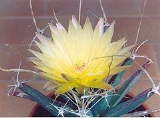
Leuchtenbergia
Encyclopedia
Leuchtenbergia principis (agave cactus or prism cactus), the sole species of the genus
Leuchtenbergia, is a species
of cactus
. It is native to north-central Mexico
(San Luis Potosi
, Chihuahua). The genus is named after Maximilian Eugen Joseph
(1817-1852), duke of Leuchtenberg
and amateur botanist.
It is very slow-growing but can eventually grow up to 70 cm high, with a cylindrical stem which becomes bare and corky at the base with age. It has long, slender, grayish-green tubercle
s 6-12 cm long, with purplish-red blotches at their tips. The tubercles are topped with papery spines, making the plant resemble an agave
; old, basal tubercles dry up and fall off. After four years or so, yellow, funnel-shaped flowers 5-6 cm diameter may be borne at the tubercle tips. The fruit
is smooth and green, 3 cm long and 2 cm broad. It has a large, tuberous taproot.
, and hybrids have been created between these two genera.
Genus
In biology, a genus is a low-level taxonomic rank used in the biological classification of living and fossil organisms, which is an example of definition by genus and differentia...
Leuchtenbergia, is a species
Species
In biology, a species is one of the basic units of biological classification and a taxonomic rank. A species is often defined as a group of organisms capable of interbreeding and producing fertile offspring. While in many cases this definition is adequate, more precise or differing measures are...
of cactus
Cactus
A cactus is a member of the plant family Cactaceae. Their distinctive appearance is a result of adaptations to conserve water in dry and/or hot environments. In most species, the stem has evolved to become photosynthetic and succulent, while the leaves have evolved into spines...
. It is native to north-central Mexico
Mexico
The United Mexican States , commonly known as Mexico , is a federal constitutional republic in North America. It is bordered on the north by the United States; on the south and west by the Pacific Ocean; on the southeast by Guatemala, Belize, and the Caribbean Sea; and on the east by the Gulf of...
(San Luis Potosi
San Luis Potosí
San Luis Potosí officially Estado Libre y Soberano de San Luis Potosí is one of the 31 states which, with the Federal District, comprise the 32 Federal Entities of Mexico. It is divided in 58 municipalities and its capital city is San Luis Potosí....
, Chihuahua). The genus is named after Maximilian Eugen Joseph
Maximilian, Duke of Leuchtenberg
Maximilian Joseph Eugene Auguste Napoleon de Beauharnais , 3rd Duke of Leuchtenberg, 3rd Prince of Venice Prince des Français and Hereditary Prince of the Kingdom of Italy and claimant to the Grand Duchy of Frankfurt was the husband of Grand Duchess Maria Nikolayevna of...
(1817-1852), duke of Leuchtenberg
Leuchtenberg
Leuchtenberg is a municipality in the district of Neustadt in Bavaria in Germany, essentially a suburb of nearby Weiden in der Oberpfalz, and a historical region in Old Germany governed by the Landgrave of Leuchtenberg....
and amateur botanist.
It is very slow-growing but can eventually grow up to 70 cm high, with a cylindrical stem which becomes bare and corky at the base with age. It has long, slender, grayish-green tubercle
Tubercle
A tubercle is generally a wart-like projection, but it has slightly different meaning depending on which family of plants or animals it is used to refer to....
s 6-12 cm long, with purplish-red blotches at their tips. The tubercles are topped with papery spines, making the plant resemble an agave
Agave
Agave is a genus of monocots. The plants are perennial, but each rosette flowers once and then dies ; they are commonly known as the century plant....
; old, basal tubercles dry up and fall off. After four years or so, yellow, funnel-shaped flowers 5-6 cm diameter may be borne at the tubercle tips. The fruit
Fruit
In broad terms, a fruit is a structure of a plant that contains its seeds.The term has different meanings dependent on context. In non-technical usage, such as food preparation, fruit normally means the fleshy seed-associated structures of certain plants that are sweet and edible in the raw state,...
is smooth and green, 3 cm long and 2 cm broad. It has a large, tuberous taproot.
Taxonomy
It is related to the genus FerocactusFerocactus
Ferocactus is a genus of large barrel-shaped cacti, mostly with large spines and small flowers. There are about 30 species included in the genus. They are found in the southwestern United States and northwestern Mexico. The young specimens are columnar but as they grow older ribs form and they take...
, and hybrids have been created between these two genera.

